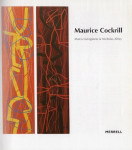SPECTRAL RIVERS, 2000-1, 6 panels
11926
Polyptych : six separate canvases
Each panel height 244, length 61cm, total length 366cm
Price on application
" The anatomy of the landscape - the River estuary, fields and woods, clouds, hills and mountains beyond is forever in flux, due not simply to the capriciousness of light and weather, but also in regard to whatever I, the artist, bring to it and hope to find there." Maurice Cockrill
• Spectral Rivers comprises six separate canvases offering a rare opportunity to acquire a complete series by the artist.
• It has the flexibility of being hung together closely, more spaciously or independently in different positions within a single interior or multiple spaces.
• The work was exhibited at the Royal Academy, London in 2001.
• Cockrill's studio overlooked the Conwy estuary and Spectral Rivers is a sequence of direct, unique responses to the spectral properties of the river topology alluding to different layers of consciousness ; the spirit of the waters perhaps flowing in some alternative dimension, or phantom river-system beyond the limits of our physical world.
• The 'spectral' of the title has another meaning as the canvases are ordered according to the colour sequence of the spectrum (though there is no indigo, in a subtle side-stepping of a purely schematic arrangement).
• The colours used also reflect the affect of different light conditions on the river.
' Matisse said, 'Exactitude is not truth' . My pictures are the landscape transfigured - separate utterances , complete-in-themselves although partial, that grope towards an understanding and expression of the spirit of this piece of the world that has held poetic meaning for me for over half a century. ' Maurice Cockrill
• The initial impulse for Spectral Rivers came from the 16th century Japanese painter-poet Koetsu and started with a group of exploratory drawings illustrated below. Taking the the form of longs scrolls worked on the floor in which the script like design was laid down in black, white, dark red and grey on a ground splashed with gold powder.
• In the Spectral Rivers paintings, bold, angular signs are intertwined with more delicate filament, creating an effect of subtle amelioration.
" I'd rather be changing shape than just be doing the same thing time after time." Maurice Cockrill
Rivers were important to Cockrill evoking birth, maturity, decay and regeneration, the cycles of life that echo these central human preoccupations.
This series of fluid, abstract paintings evoke nature, the elements, the progress of the Conwy river to maturity and the scars that humans cut into the land.
The serpentine and lyrical curves in the individual compositions reveal Cockrill's preoccupation with organic forms, especially water and the phases of a river flowing around the canvas.
The bravado in the sweeping paint and scintillating colour is Cockrill's signature, and there is perhaps no artist who handles paint with a more fluid skill
LITERATURE :
Illustrated on the frontispiece and discussed p24-5, Maurice Cockrill, Marco Livingstone & Nicholas Alfrey
PROVENANCE :
Private Collection
Paisnel Gallery
The artist
EXHBITITED :
Royal Academy, London 2001
RELATED :
The enigmatic writing seems to relate at some level to the repeated, downward flowing river-maps of 'Afron Cycle'.
Comprehensive cataloguing available on request
' His imagination is mercurial; his creative methodologies are resourcefully experimental; his invention is diverse and virtuosic.
Each new phase of his painting presents us with yet another high definition performance, something not anticipated, as if he was incapable of repeating the previous act, and felt impelled every time to respond to Diaghilev's imperious injunction: 'Étonne-moi!"
Mel Gooding
Frequently referred to as a 'painter's painter', Maurice Cockrill creates wonderfully vibrant and bold canvases ranging extensively in their style, from photographic realism to expressionism and near abstraction.
Maurice Cockrill RA was one of the most versatile painters to have emerged in the UK since the Second World War.
Restless, lyrical and challenging, his work was constantly evolving, defying conventional categorization. Throughout the decades, Cockrill opened his eyes to the world again and again, each time shifting the paint in a new way to reflect each layer of vision. He is famous for his breadth of techniques and themes.




































